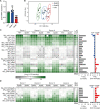Neutrophil-derived reactive agents induce a transient SpeB negative phenotype in Streptococcus pyogenes
- PMID: 37430325
- PMCID: PMC10331992
- DOI: 10.1186/s12929-023-00947-x
Neutrophil-derived reactive agents induce a transient SpeB negative phenotype in Streptococcus pyogenes
Abstract
Background: Streptococcus pyogenes (group A streptococci; GAS) is the main causative pathogen of monomicrobial necrotizing soft tissue infections (NSTIs). To resist immuno-clearance, GAS adapt their genetic information and/or phenotype to the surrounding environment. Hyper-virulent streptococcal pyrogenic exotoxin B (SpeB) negative variants caused by covRS mutations are enriched during infection. A key driving force for this process is the bacterial Sda1 DNase.
Methods: Bacterial infiltration, immune cell influx, tissue necrosis and inflammation in patient´s biopsies were determined using immunohistochemistry. SpeB secretion and activity by GAS post infections or challenges with reactive agents were determined via Western blot or casein agar and proteolytic activity assays, respectively. Proteome of GAS single colonies and neutrophil secretome were profiled, using mass spectrometry.
Results: Here, we identify another strategy resulting in SpeB-negative variants, namely reversible abrogation of SpeB secretion triggered by neutrophil effector molecules. Analysis of NSTI patient tissue biopsies revealed that tissue inflammation, neutrophil influx, and degranulation positively correlate with increasing frequency of SpeB-negative GAS clones. Using single colony proteomics, we show that GAS isolated directly from tissue express but do not secrete SpeB. Once the tissue pressure is lifted, GAS regain SpeB secreting function. Neutrophils were identified as the main immune cells responsible for the observed phenotype. Subsequent analyses identified hydrogen peroxide and hypochlorous acid as reactive agents driving this phenotypic GAS adaptation to the tissue environment. SpeB-negative GAS show improved survival within neutrophils and induce increased degranulation.
Conclusions: Our findings provide new information about GAS fitness and heterogeneity in the soft tissue milieu and provide new potential targets for therapeutic intervention in NSTIs.
Keywords: Necrotizing soft tissue infections; Neutrophils; SpeB; Streptococcus pyogenes.
© 2023. The Author(s).
Figures






References
-
- Bruun T, Kittang BR, de Hoog BJ, Aardal S, Flaatten HK, Langeland N, Mylvaganam H, Vindenes HA, Skrede S. Necrotizing soft tissue infections caused by Streptococcus pyogenes and Streptococcus dysgalactiae subsp. equisimilis of groups C and G in western Norway. Clin Microbiol Infect. 2013;19(12):E545–550. doi: 10.1111/1469-0691.12276. - DOI - PubMed
-
- Bruun T, Rath E, Bruun Madsen M, Oppegaard O, Nekludov M, Arnell P, Karlsson Y, Babbar A, Bergey F, Itzek A, Hyldegaard O, Norrby-Teglund A, Skrede S. Risk factors and predictors of mortality in streptococcal necrotizing soft-tissue infections: a multicenter prospective study. Clin Infect Dis. 2020;72:293. doi: 10.1093/cid/ciaa027. - DOI - PMC - PubMed
MeSH terms
Substances
Grants and funding
LinkOut - more resources
Full Text Sources

